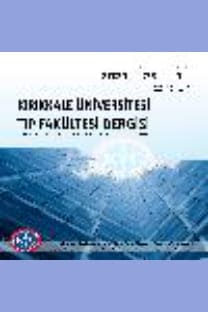KIRIKKALE İLİNDE YAŞAYAN 3-6 YAŞLARI ARASINDAKİ ÇOCUKLARDA SÜT DİŞİ DENTAL EROZYON PREVALANSININ DEĞERLENDİRİLMESİ
Erozyon, süt dişleri, BEWE
Evaluation of Dental Erosion Prevalence in Primary Teeth of 3-6 Years Old Children Living in
Erosion, primary teeth, BEWE,
___
- 1. Al-Malik MI, Holt RD, Bedi R. The Relationship Between Erosion, Caries and Rampant Caries and Dietary Habits in Preschool Children in Saudi Arabia. Int J Paediatr Dent. 2001;11:430-439
- 2. Ayers KM, Drummond BK, Thomson WM, Kieser JA. Risk indicators for tooth wear in New Zealand school children. Int Dent J. 2002;52(1):41–46
- 3. Bardsley PF .The evolution of tooth wear indices. Clin Oral Invest (in press). 2008.
- 4. Bartlett D, Ganss C, Lussi A. Basic Erosive Wear Examination (BEWE): new scoring system for scientific and clinical needs. Clin Oral Investig. 2008;12(Suppl 1):S65-S68
- 5. Civelek A, Özel E. Dental Erozyon ve Ayırıcı Tanısı. GÜ Dişhek Fak Derg. 2005;22(1):69-74.
- 6. El Aidi H, Bronkkhorst EM, Huysmans MC, Truin GJ. Dynamics of tooth erosion in adolescents: a 3-year longitudinal study. J Dent. 2010;38(2):131-37
- 7. El Aidi H, Bronkkhorst EM, Huysmans MC, Truin GJ. Multifactorial Analysis of Factors Associated with the Incidence and Progression of Erosive Tooth Wear. Caries Res. 2011;45(3):303-12
- 8. Ercan E, Kaya Demirbaş A. Dental Erozyon. İstanbul Üniversitesi Diş Hekimliği Fakültesi Dergisi. 2013;Cilt:47, Sayı:3 Sayfa:73-82
- 9. Ganss C, Klimek J, Giese K. Dental erosion in children and adolescents: a cross-sectional and longitudinal investigation using study models. Commun Dent Oral Epidemiol. 2001;29 264–271.
- 10. Ganss C, Klimek J, Giese K. Dental erosion in children and adolescents a cross-sectional and longitudinal investigation using study models. Community Dent Oral Epidemiol. 2001;29:264–271
- 11. Ganss C, Lussi A. Diagnosis of Erosive Tooth Wear. Monogr Oral Sci. 2006; 20:32-43
- 12. Gatou T, Mamai-Homata E. Tooth wear in the deciduous dentition of 5-7-year-old children: risk factors. Clin Oral Invest. 2012;16(3):923-33
- 13. Gilmour AG, Beckett HA. The voluntary reflux phenomenon. Br Dent J. 1993;104:178-190
- 14. Harding MA, Whelton H, O’Mullane DM, Cronin M. Dental erosion in 5-year-old Irish school children and associated factors: a pilot study. Community Dent Health. 2003;20(3):165-170
- 15. Holbrook WP, Ganss C. Is diagnosing exposed dentine a suitable tool for grading erosive loss? Clin Oral Invest. 2008;12(Suppl 1):S33–S39
- 16. Imfeld T. Prevention of Progression of Dental Erosion by Professional and İndividual Prophylactic Measures. Eur J Oral Sci. 1996;104:215-220
- 17. Imfeld T. Dental erosion: Definitions, classification and links. Eur J Oral Sci. 1996;104:151-155
- 18. Johansson A. A cross-cultural study of occlusal tooth wear. Swed Dent J Suppl. 1992;86:1-59
- 19. Johansson AK, Omar R, Carlsson GE, Johansson A. Dental Erosion and its Growing Importance in Clinical Practice:From Past to Present. Int J Dent. 2012; 2012:32907.
- 20. Khan F, Young WG, Law V, Priest J, Daley TJ Cupped Lesion of Early onset Dental Erosion in Young Southeast Queensland Adults. Aust Dent J. 2001;46:100-107
- 21. Lussi A, Jaeggi T, Zero D. The Role of Diet in The Aetiology of Dental Erosion. Caries Res. 2004;38 Suppl 1:S 34-44
- 22. Lussi A, Jaeggi T. Dental Erosion in Children. Monogr Oral Sci. 2006; 20:140-151
- 23. Lussi A, Jaeggi T. Erosion-Diagnosis and Risk Factor. Clin Oral Investig. 2008;12 Suppl 1:S5-13
- 24. Lussi A. Dental erosion clinical diagnosis and case history taking. Eur J Oral Sci. 1996;104:191-198
- 25. Kreulen CM, Van't Spijker A, Rodriguez JM, Bronkhorst EM, Creugers NH, Bartlett DW Systematic review of the prevalence of tooth wear in children and adolescents. Caries Res. 2010;44(2):151–159
- 26. Maden Arat E. Dental Erozyonda Tanı ve Tedavi Yöntemleri. Gülhane Tıp Dergisi. 2012;54:86-91
- 27. Mantonanaki M, Koletsi-Kounari H, Mamai-Homata E, Papaioannou W, Dental erosion prevalence and associated risk indicators among preschool children in Athens, Greece. Clin. Oral. Invest. 2013;17:585–593.
- 28. Nunn JH, Gordon PH, Morris AJ, Pince CM, Walker A. Dental Erosion-Changing Prevalence? A Review of British National Children‘s Surveys. Int J Pediat Dent. 2003;13:98-105
- 29. O’Sullivan EA, Curzon ME. A Comparison of Acidic Dietary Factor in Children with and Without Dental Erosion. ASDC J Dent Child. 2000;67:186-192
- 30. Roberson TM, Sturdevant CM. Sturdevent’s, the Art and Science of Operative Dentistry. 4th ed., Missouri:Mosby, 2002, p.269-306
- 31. Taji S, Seow WK. A Literature Review of Dental Erosion in Children. Australian Dent J. 2010;55:358-367
- 32. Taji S, Seow K, Townsend G, Holcombre T. A controlled study of dental erosion in 2- to 4-year-old twins. Int J Paediatr Dent. 2010;20:400–409
- 33. Tschammler C, Müller-Pflanz C, Attin T, Müller J, Wiegand A. Prevalence and risk factors of erosive tooth wear in 3-6 year old German kindergarten children-A comparison between 2004/05 and 2014/15. J Dent. 2016 Sep;52:45-9. doi: 10.1016/j.jdent.2016.07.003.
- 34. Wiegand A, Muller J, Werner C, Attin T. Prevalence of Erosive Tooth Wear and Associated Risk Factor in 2-7-year-old German Kindergarten Children. Oral Diseases. 2006;12,117-124
- ISSN: 2148-9645
- Yayın Aralığı: Yılda 3 Sayı
- Başlangıç: 1999
- Yayıncı: KIRIKKALE ÜNİVERSİTESİ KÜTÜPHANE VE DOKÜMANTASYON BAŞKANLIĞI
Seval BAYRAK, Kemal Özgür DEMİRALP, Emine Şebnem KURŞUN ÇAKMAK
HEMŞİRELİK ÖĞRENCİLERİNİN AĞIZ DİŞ SAĞLIĞI ALGILARININ BELİRLENMESİ
HÜSNA ÖZVEREN, EMEL GÜLNAR, DİLEK ÖZDEN
ERCAN YUVANÇ, DEVRİM TUĞLU, ÜÇLER KISA, Önder BOZDOĞAN, Ertan BATİSLAM, Erdal YILMAZ
2017 ST YÜKSELMELİ MİYOKART ENFARKTÜSÜ KILAVUZUNDA YENİLİKLER
VOLKAN ARIKAN, Kamile Nur VAPUR, AYLİN AKBAY OBA
İNFERTİL BİR ERKEKTE 46XX TESTİKÜLER BOZUKLUK
ZAFER PEKKOLAY, FARUK KILINÇ, MAZHAR MÜSLÜM TUNA, Hikmet SOYLU, ALPASLAN KEMAL TUZCU
YÜKSEK DOZ SERTRALİN ALIMINA BAĞLI GELİŞEN SEROTONİN SENDROMU
GÜLÇİN AYDIN, IŞIN GENÇAY, SELİM ÇOLAK
Hasan HATİPOĞLU, Hüseyin Gencay KEÇELİ, Faik YAYLAK, Hümeyra Aydemir TURKAL
KIRIKKALE ÜNİVERSİTESİ HASTANESİ İÇİN YATAN HASTA MEMNUNİYETİ: BİR ÖLÇEK GELİŞTİRME ÇALIŞMASI
FUNDA ERDUGAN, SERAP YÖRÜBULUT
MYOMETRİUM LOKALİZASYONLU RAHİM İÇİ ARAÇ
CEMİLE DAYANGAN SAYAN, ZEHRA SEMA ÖZKAN, GÜLÇİN AYDIN, Funda ERDOĞAN, Zeynep İSLAMBAY
